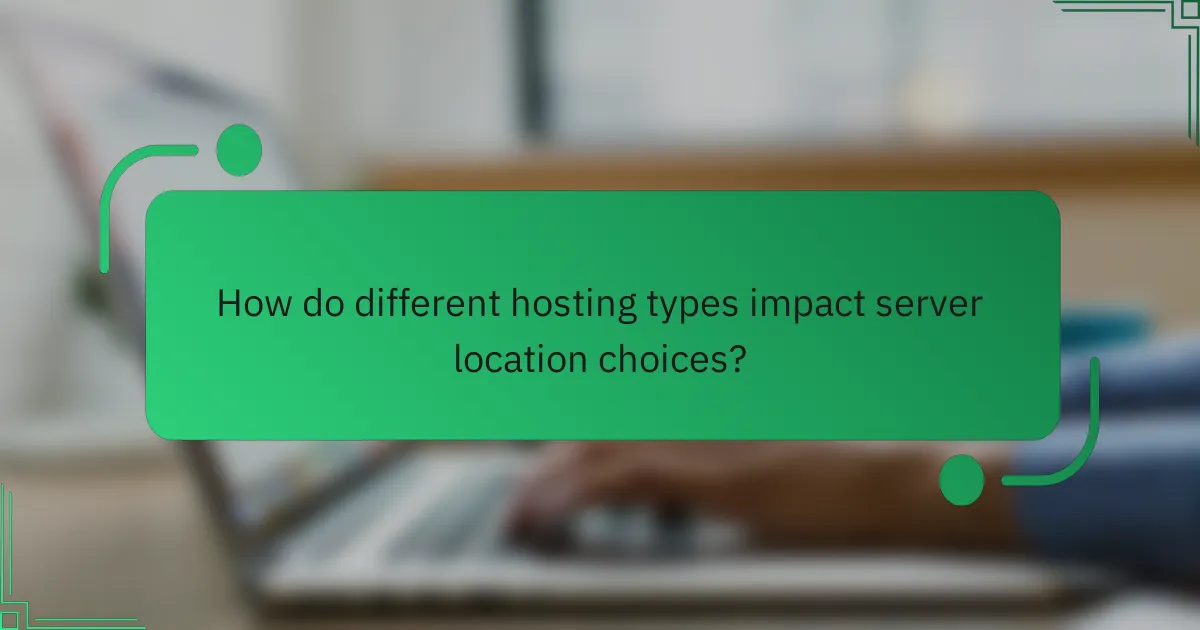The location of a server plays a crucial role in determining website speed for local businesses in the UK. By positioning servers closer to the target audience, companies can achieve faster loading times, resulting in an improved user experience. Choosing a server provider with optimal geographical relevance is essential for maximising performance and minimising latency.

How does server location affect website speed for local businesses in the UK?
The location of a server significantly impacts website speed for local businesses in the UK by determining how quickly data travels between the server and users. A server situated closer to the target audience can lead to faster loading times and a better user experience.
Proximity to target audience
Proximity to the target audience is crucial for optimising website speed. When a server is located near users, the distance data must travel is shorter, which can enhance performance. For UK businesses, hosting servers within the country or even regionally can provide a noticeable advantage.
For instance, a business in London will benefit from a server located in London or nearby, rather than one situated in another country. This local hosting can lead to quicker access to the website, making it more appealing to potential customers.
Latency reduction
Latency refers to the delay before a transfer of data begins following an instruction. Reducing latency is essential for improving website speed. A server closer to users typically experiences lower latency, which means faster response times when users interact with the website.
In practical terms, lower latency can translate to a smoother browsing experience. For local businesses, aiming for server locations that minimise latency can help maintain customer engagement and reduce bounce rates.
Impact on loading times
Loading times are directly influenced by server location, as they determine how quickly a website’s content is delivered to users. A server located far from the user can lead to longer loading times, which can frustrate visitors and drive them away.
For UK local businesses, optimising server location can lead to loading times that are often within the range of 1 to 3 seconds, which is generally acceptable for user experience. Regularly testing website speed and considering local hosting options can help ensure that loading times remain competitive.

What are the best server locations for UK-based businesses?
The best server locations for UK-based businesses are those that minimise latency and enhance website speed for local users. Typically, servers situated within the UK, particularly in major cities, provide optimal performance due to their proximity to the target audience.
London data centres
London is home to numerous data centres, making it a prime location for hosting services. With a vast array of providers, businesses can choose from options that offer high reliability and low latency. The concentration of internet infrastructure in London often results in faster loading times for users in the capital and surrounding areas.
When selecting a London data centre, consider factors such as connectivity options, redundancy, and security features. Many facilities offer scalable solutions, allowing businesses to adjust their resources as they grow.
Manchester hosting services
Manchester has emerged as a significant hub for hosting services, providing an excellent alternative to London. The city’s data centres offer competitive pricing and robust performance, making them suitable for businesses looking to optimise their website speed without the premium costs associated with London.
Choosing a Manchester-based server can be particularly beneficial for businesses targeting the North West region. Ensure to evaluate the service level agreements (SLAs) and customer support options available from providers in this area.
Birmingham server options
Birmingham offers a variety of server options that cater to local businesses seeking reliable hosting solutions. The city’s strategic location in the UK allows for efficient data transfer across the country, which can enhance website performance for users in the Midlands and beyond.
When considering Birmingham for server hosting, look for providers that offer flexible plans and strong uptime guarantees. Additionally, assess the availability of local support and the potential for future scalability as your business expands.

How can local businesses choose the right server provider?
Local businesses can choose the right server provider by assessing performance, support, and geographical relevance. Selecting a provider with servers close to your target audience can significantly enhance website speed and user experience.
Evaluating server performance metrics
When evaluating server performance metrics, focus on speed, uptime, and bandwidth. Look for providers that guarantee uptime of at least 99.9% and offer low latency, ideally in the low tens of milliseconds for local traffic.
Consider testing the server’s response time using tools like Pingdom or GTmetrix. These tools can help you compare different providers and identify which one delivers the best performance for your specific location.
Considering customer support availability
Customer support is crucial for resolving issues quickly. Opt for providers that offer 24/7 support through multiple channels, such as live chat, phone, and email. This ensures that any technical problems can be addressed promptly, minimising downtime.
Check reviews and testimonials to gauge the quality of customer support. A provider with a strong reputation for responsive and knowledgeable support can save you time and frustration in the long run.

What are the implications of using a CDN for local businesses?
Using a Content Delivery Network (CDN) can significantly enhance website performance for local businesses by distributing content across multiple servers. This reduces latency, ensuring that users experience faster load times regardless of their geographical location.
Improved speed across regions
A CDN improves speed by caching content on servers located closer to users. When a user requests a webpage, the CDN serves the content from the nearest server, which can cut down loading times to low tens of milliseconds. For local businesses, this means that customers can access information quickly, leading to higher engagement rates.
Consider a local bakery in London using a CDN. If a customer in Manchester visits their website, the CDN can deliver images and product details from a server in the North West, rather than from London, enhancing speed and performance.
Enhanced user experience
Faster load times directly contribute to an enhanced user experience, which is crucial for retaining customers. Studies show that even a one-second delay can lead to significant drops in user satisfaction and conversion rates. Local businesses must prioritise speed to keep potential customers engaged.
Additionally, a CDN can help manage traffic spikes during peak times, such as holiday seasons or special promotions. This ensures that the website remains accessible and responsive, preventing potential losses due to downtime or slow performance.

How do different hosting types impact server location choices?
The choice of hosting type significantly influences server location decisions, affecting website speed and performance. Local businesses should consider how various hosting options align with their target audience’s geographical location to optimise loading times and user experience.
Shared hosting vs. dedicated servers
Shared hosting involves multiple websites using the same server resources, which can lead to slower speeds if traffic spikes occur. For local businesses, this might be suitable for low-traffic sites but can hinder performance during peak times.
In contrast, dedicated servers provide exclusive resources for a single website, allowing for faster load times and improved reliability. This option is often more expensive but is ideal for businesses with higher traffic demands or those requiring consistent performance.
Cloud hosting advantages
Cloud hosting offers flexibility by distributing resources across multiple servers, which can enhance speed and reliability. This is particularly beneficial for local businesses that experience fluctuating traffic, as resources can be scaled up or down as needed.
Additionally, cloud hosting typically allows for server locations in various regions, enabling businesses to choose a server closer to their target audience. This can significantly reduce latency and improve the overall user experience, making it a strong option for local enterprises aiming to attract nearby customers.

What are the costs associated with server location decisions?
The costs associated with server location decisions can vary significantly based on factors such as geographical region, infrastructure quality, and local regulations. Businesses must consider both initial setup costs and ongoing operational expenses when selecting a server location to optimise website speed and performance.
Pricing variations by region
Server costs can differ widely across regions due to variations in energy prices, real estate costs, and local labour rates. For instance, hosting services in Western Europe may be more expensive compared to Eastern Europe, where operational costs are generally lower. Businesses should compare pricing models from different regions to find the best fit for their budget.
Additionally, consider the potential impact of local taxes and regulations on hosting fees. Some countries may impose higher VAT rates or specific compliance costs that could affect overall expenses. It’s crucial to factor these elements into the total cost of ownership when making server location decisions.
Long-term investment considerations
Choosing a server location is not just a short-term expense; it can significantly influence long-term business performance. A strategically located server can enhance website speed, leading to improved user experience and potentially higher conversion rates. Investing in a reliable server location can yield substantial returns over time.
Moreover, businesses should evaluate the scalability of their chosen server solution. As a company grows, the ability to expand server capacity without incurring excessive costs is vital. Opting for a location with robust infrastructure and support can facilitate smoother growth and minimise future migration costs.

What are the emerging trends in server location and website speed?
Emerging trends in server location are significantly influencing website speed, particularly for local businesses. As more companies recognise the importance of fast loading times, they are increasingly adopting strategies like edge computing and content delivery networks (CDNs) to enhance user experience.
Edge computing developments
Edge computing is reshaping how data is processed and delivered by bringing computation closer to the user. This decentralised approach reduces latency, as data does not have to travel long distances to reach the server, resulting in faster response times for websites.
For local businesses, implementing edge computing can mean hosting data on servers located within the same region as their target audience. This can lead to improved website performance, especially for applications requiring real-time data processing, such as e-commerce platforms or interactive services.
However, businesses should consider the trade-offs, such as the initial investment in infrastructure and the need for ongoing maintenance. It’s essential to evaluate whether the benefits of reduced latency and enhanced speed justify these costs in the context of their specific operations.